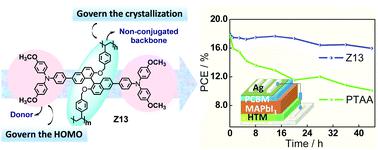当前位置:
X-MOL 学术
›
Mater. Chem. Front.
›
论文详情
Our official English website, www.x-mol.net, welcomes your
feedback! (Note: you will need to create a separate account there.)
Polymeric hole-transporting material with a flexible backbone for constructing thermally stable inverted perovskite solar cells
Materials Chemistry Frontiers ( IF 6.0 ) Pub Date : 2021-08-17 , DOI: 10.1039/d1qm00869b Wenhua Zhang 1 , Xueping Zong 1 , Ming Luo 1 , Mengnan Hua 1 , Lianjie Zhu 1 , Mao Liang 1 , Song Xue 1
Materials Chemistry Frontiers ( IF 6.0 ) Pub Date : 2021-08-17 , DOI: 10.1039/d1qm00869b Wenhua Zhang 1 , Xueping Zong 1 , Ming Luo 1 , Mengnan Hua 1 , Lianjie Zhu 1 , Mao Liang 1 , Song Xue 1
Affiliation

|
The explored p–i–n inverted architecture perovskite solar cells (i-PSCs) show promising application in flexible, large-scale and laminated photovoltaic technology. Polymeric HTMs for i-PSCs have been rarely reported. Thus far, only a commercial hole-transporting material, polytriarylamine (PTAA), has achieved a significant PCE of over 23% in i-PSCs. However, a perovskite precursor exhibits poor wettability on the PTAA films, thereby reducing their reproducibility and causing uncontrollable device instability. In this study, a type of binaphthyl-ether based polymer Z13 was developed through radical polymerization to replace the palladium catalyzed coupling reaction. A small molecule (Z5) and commercial PTAA were classified as the control. The comparatively flexible ether bond (–O–) of the backbone in Z13 improved the solubility and film forming properties of the material, thereby contributing to a superior morphology uniformity of the deposited perovskite. Consequently, promising device performance was achieved for i-PSCs endowed with Z13. The maximum power conversion efficiency of 18.80% obtained for Z13 was comparable with that of PTAA (19.02%), exceeding that with Z5 (18.48%). More importantly, Z13 films ensured a significantly optimized device thermal-durability as opposed to references PTAA and Z5. This study proposed a promising design for novel polymeric materials with low costs, high production reproducibility, favorable solubility and excellent optoelectronic properties.
中文翻译:

具有柔性骨架的聚合物空穴传输材料,用于构建热稳定的倒置钙钛矿太阳能电池
探索的 p-i-n 倒置结构钙钛矿太阳能电池 (i-PSC) 在柔性、大规模和层压光伏技术中显示出有前景的应用。用于 i-PSC 的聚合物 HTM 很少有报道。迄今为止,只有商用空穴传输材料聚三芳基胺 (PTAA) 在 i-PSC 中实现了超过 23% 的显着 PCE。然而,钙钛矿前驱体在 PTAA 薄膜上的润湿性较差,从而降低了它们的可重复性并导致器件不稳定。在这项研究中,通过自由基聚合开发了一种联萘-醚基聚合物 Z13,以取代钯催化的偶联反应。小分子 (Z5) 和商业 PTAA 被归类为对照。Z13 骨架的相对灵活的醚键 (-O-) 提高了材料的溶解性和成膜性能,从而有助于沉积钙钛矿的优异形态均匀性。因此,赋予 Z13 的 i-PSC 实现了有希望的设备性能。Z13 获得的最大功率转换效率为 18.80%,与 PTAA(19.02%)相当,超过了 Z5(18.48%)。更重要的是,与参考 PTAA 和 Z5 相比,Z13 薄膜确保了显着优化的设备耐热性。该研究为具有低成本、高生产重现性、良好溶解性和优异光电性能的新型聚合物材料提出了一种有前景的设计。从而有助于沉积钙钛矿的优异形态均匀性。因此,赋予 Z13 的 i-PSC 实现了有希望的设备性能。Z13 获得的最大功率转换效率为 18.80%,与 PTAA(19.02%)相当,超过了 Z5(18.48%)。更重要的是,与参考 PTAA 和 Z5 相比,Z13 薄膜确保了显着优化的设备耐热性。该研究为具有低成本、高生产重现性、良好溶解性和优异光电性能的新型聚合物材料提出了一种有前景的设计。从而有助于沉积钙钛矿的优异形态均匀性。因此,赋予 Z13 的 i-PSC 实现了有希望的设备性能。Z13 获得的最大功率转换效率为 18.80%,与 PTAA(19.02%)相当,超过了 Z5(18.48%)。更重要的是,与参考 PTAA 和 Z5 相比,Z13 薄膜确保了显着优化的设备耐热性。该研究为具有低成本、高生产重现性、良好溶解性和优异光电性能的新型聚合物材料提出了一种有前景的设计。更重要的是,与参考 PTAA 和 Z5 相比,Z13 薄膜确保了显着优化的设备耐热性。该研究为具有低成本、高生产重现性、良好溶解性和优异光电性能的新型聚合物材料提出了一种有前景的设计。更重要的是,与参考 PTAA 和 Z5 相比,Z13 薄膜确保了显着优化的设备耐热性。该研究为具有低成本、高生产重现性、良好溶解性和优异光电性能的新型聚合物材料提出了一种有前景的设计。
更新日期:2021-09-01
中文翻译:

具有柔性骨架的聚合物空穴传输材料,用于构建热稳定的倒置钙钛矿太阳能电池
探索的 p-i-n 倒置结构钙钛矿太阳能电池 (i-PSC) 在柔性、大规模和层压光伏技术中显示出有前景的应用。用于 i-PSC 的聚合物 HTM 很少有报道。迄今为止,只有商用空穴传输材料聚三芳基胺 (PTAA) 在 i-PSC 中实现了超过 23% 的显着 PCE。然而,钙钛矿前驱体在 PTAA 薄膜上的润湿性较差,从而降低了它们的可重复性并导致器件不稳定。在这项研究中,通过自由基聚合开发了一种联萘-醚基聚合物 Z13,以取代钯催化的偶联反应。小分子 (Z5) 和商业 PTAA 被归类为对照。Z13 骨架的相对灵活的醚键 (-O-) 提高了材料的溶解性和成膜性能,从而有助于沉积钙钛矿的优异形态均匀性。因此,赋予 Z13 的 i-PSC 实现了有希望的设备性能。Z13 获得的最大功率转换效率为 18.80%,与 PTAA(19.02%)相当,超过了 Z5(18.48%)。更重要的是,与参考 PTAA 和 Z5 相比,Z13 薄膜确保了显着优化的设备耐热性。该研究为具有低成本、高生产重现性、良好溶解性和优异光电性能的新型聚合物材料提出了一种有前景的设计。从而有助于沉积钙钛矿的优异形态均匀性。因此,赋予 Z13 的 i-PSC 实现了有希望的设备性能。Z13 获得的最大功率转换效率为 18.80%,与 PTAA(19.02%)相当,超过了 Z5(18.48%)。更重要的是,与参考 PTAA 和 Z5 相比,Z13 薄膜确保了显着优化的设备耐热性。该研究为具有低成本、高生产重现性、良好溶解性和优异光电性能的新型聚合物材料提出了一种有前景的设计。从而有助于沉积钙钛矿的优异形态均匀性。因此,赋予 Z13 的 i-PSC 实现了有希望的设备性能。Z13 获得的最大功率转换效率为 18.80%,与 PTAA(19.02%)相当,超过了 Z5(18.48%)。更重要的是,与参考 PTAA 和 Z5 相比,Z13 薄膜确保了显着优化的设备耐热性。该研究为具有低成本、高生产重现性、良好溶解性和优异光电性能的新型聚合物材料提出了一种有前景的设计。更重要的是,与参考 PTAA 和 Z5 相比,Z13 薄膜确保了显着优化的设备耐热性。该研究为具有低成本、高生产重现性、良好溶解性和优异光电性能的新型聚合物材料提出了一种有前景的设计。更重要的是,与参考 PTAA 和 Z5 相比,Z13 薄膜确保了显着优化的设备耐热性。该研究为具有低成本、高生产重现性、良好溶解性和优异光电性能的新型聚合物材料提出了一种有前景的设计。











































 京公网安备 11010802027423号
京公网安备 11010802027423号